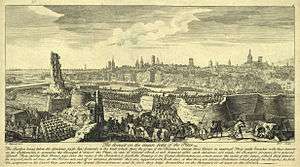Siege of Barcelona (1713–14)
| Siege of Barcelona | |||||||
|---|---|---|---|---|---|---|---|
| Part of the War of the Spanish Succession | |||||||
 | |||||||
| |||||||
| Belligerents | |||||||
|
|
| ||||||
| Commanders and leaders | |||||||
|
Duke of Popoli Duke of Berwick |
Antoni de Villarroel Rafael Casanova | ||||||
| Strength | |||||||
|
40,000 regulars 80 cannons 20 howitzers |
2,000 regulars of the Army of Catalonia 4,700 militians of the Coronela Some piece of artillery | ||||||
| Casualties and losses | |||||||
| 10,000 dead or wounded | 13,000 dead or wounded | ||||||
The Siege of Barcelona (Catalan: Setge de Barcelona, IPA: [ˈsedʒə ðə βərsəˈɫonə]) was a battle at the end of the War of Spanish Succession, which pitted Archduke Charles of Austria (backed by Britain and the Netherlands, i.e. the Grand Alliance), against Philip V of Spain, backed by France in a contest for the Spanish crown.
Prelude
During the early part of the war, Barcelona, the capital of Catalonia, had fallen to the forces of Archduke Charles: his fleet had anchored in the port on 22 August 1705, landing troops which surrounded the city. These troops later captured the fort of Montjuïc, and used it to bombard the city into submission on October 9. The Principality, as well as the other States of the Crown of Aragon, quickly accepted Charles III as their new king. Charles summoned the last Catalan Courts of history.
Battle
As the freshly defeated Catalan Court supported the Archduke against Philip V, the Franco-Spanish forces were not strong enough to attempt a recapture of the city until 1713. When the Treaty of Utrecht was signed between April and July, Catalonia remained (alongside Majorca) the only realm of which still fought for the cause of Charles III. By 9 July, the General Estates of Catalonia decided to continue the war in order to defend the Catalan constitutions.
By 25 July of that year, the city of Barcelona was surrounded by Bourbon forces under the command of Restaino Cantelmo-Stuart, Duke of Popoli, but attacks upon it were unfruitful due to the scarcity of artillery. The Bourbons then waited for a 20,000 man reinforcement force, which arrived in April–May 1714. Under the command of Duke of Berwick, the assault was renewed despite the efforts of the Catalans to break the siege by sending troops behind enemy lines. After entering the city on 30 August, the Bourbons finally triumphed on 11 September, when the assault which started at 4:30 in the morning was successful, as the wall fell in several places and the Conseller en cap and chief commander of the Coronela (the urban militia of Barcelona), Rafael Casanova, was wounded during the fight. The day was marked by fighting in the streets, led by Antoni de Villarroel, the general commander of the Army of Catalonia, who was also wounded. Finally, the Catalan leaders decided to surrender and start the negotiations about capitulation. The talks were extended until the next day, because Philip V wanted to punish the population without any agreement, but Berwick, fearing a prolonged struggle, formally accepted to respect the lives of Barcelonians.
This defeat represents the end of the Principality of Catalonia as a political entity, as its independent institutions and legislation were suppressed and replaced by Castilian ones in order to establish absolutism. This event is now commemorated as the National Day of Catalonia, known in Catalan as the Diada Nacional de Catalunya.
Notes:
- Britain and the Dutch Republic reached a peace agreement to end the war with France on 11 April 1713, Treaty of Utrecht
- Austria reached a peace agreement to end the war with France on 7 March 1714, Treaty of Rastatt
- The Holy Roman Empire reached a peace agreement to end the war with France on 7 September 1714, Treaty of Baden
Aftermath
The surrender of the pro-Archduke forces to the Franco-Spanish army in 1714 was not only the end of the war, but also a phase in the centralization of various monarchies on the European continent which had been going on for two centuries. With the War of the Spanish Succession completed, Spain evolved from a personal union of different states to a centralized kingdom. The defenders of the city were buried in a cemetery, now a plaça (in Catalan: square) called Fossar de les Moreres, where Catalans gather every 11 September, known as the National Day of Catalonia or la Diada.
References
- ↑ Catalonia was fighting unilaterally by its own decision since 9 July 1713
External links
- Documents about the case of the Catalans dated on 1714, at the House of Lords, UK.
- Journal of the House of Lords: volume 19, 2 August 1715, Further Articles of Impeachment against E. Oxford brought from H.C. Article VI.
Coordinates: 41°24′07″N 2°10′00″E / 41.4019°N 2.1667°E